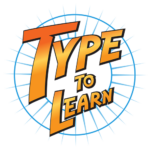Making the decision to learn how to touch type could be one of the smartest investments of your time you can make, especially at a young age. We fully support learning proper touch typing at any age, and want to make that process fun and easy for anyone starting that journey. This helpful guide outlines everything you need to know to start learning how to type, including proper ergonomics, progress goals, helpful tips and of course, free typing games.
Ergonomics Really Are Important
We get it…nobody likes to be lectured about proper typing technique when sitting down to start practicing. However, good positioning and ergonomics cannot be overlooked when you’re first learning how to type. If you’re not careful, poor body position can cause wrist and neck strain, even injury, over time. Plus, practicing good habits is so much easier than trying to break bad habits in the future. It is highly recommended that you take these ergonomics seriously and do your best to remember them each and every time you sit down to type.
Seven Ergonomics for Proper Keyboarding
- Keep your feet flat on the floor so your knees create a 90 degree angle.
- Sit up with your back straight. Don’t slouch.
- Your wrists should be straight. Your hand should not be bent up or down. You should be able to rest a coin on the back of your hand without it sliding off.
- Curve your fingers down so you can tap the keys quickly.
- Look straight ahead. Your computer monitor should be as close to eye level as possible so your neck is not tilted up or down.
- Keep your elbows in at your sides.
- Take breaks! At the very least, look away from your computer screen every few minutes to help avoid eye strain. If you’re typing for more than 15 minutes, be sure to take a break to stand up and move around for at least 60 seconds about halfway through your allotted time.
Free Ergonomic Exercises Infographic!
Seven Ergonomic Exercises to Do While Typing Download this free infographic to see seven quick and easy exercises you and your students can do in the classroom to help them understand the importance of proper ergonomics.
Start With These Four Rules of Typing
These may not seem like rules, but you should think of them as such. Engrain the following four points in your mind as rules to follow so you stick to them every time you practice typing. If you’re able to follow these rules, your experience learning how to touch type will be much better.
Don’t Look At The Keyboard
Resist every urge you have to look at the keyboard when typing. It’s okay to look down and make sure your fingers are on the right keys or where to put a finger when learning how to reach a new key. But when actually typing, keep your eyes on the screen at all times. Use the bumps on the J and F keys to center your hands and go slow.
Focus on Accuracy, Not Speed
Nobody starts out learning how to type with amazing speed, it’s impossible. Take your time and go slow, making sure you’re tapping the correct letters. You’re training your brain and hands to work together without thinking…you’re developing muscle memory. This process takes time, and it’s important that your “muscles” are remembering the correct movements. An increase in speed will happen naturally.
Try to Type With Rhythm
As you develop your typing skills you will find that some combinations of letters are easier to type than others and so you type them quickly, while others are harder and you end up typing those slowly. Even if your index fingers are doing great but your pinkies are not, try typing rhythmically, or with the same speed across all fingers. This rule will help your muscle memory developer faster and will help you increase your speed later in the learning process. Remember the old saying: slow and steady.
Be Patient
It can be aggravating when first learning how to touch type because you will inevitably make mistakes. Your hands and fingers may not want to move the way they need to, and that’s okay! Learning to type is a process that takes time. Your hands need to get stronger, your mind needs to learn, and until everything works together, you will make mistakes. But stick with it. No matter how fast or slow you learn, you will learn if you are patient and stick with it.
How long does it take to learn touch typing?
It’s almost impossible to give an exact answer to this question because every person learning to type is a different age with different hand sizes, vocabularies and reading levels. Plus everyone is at a different stage in the learning process and may have different timelines for how soon they want to learn touch typing.
That being said, the below timeline and goals are what we consider to be a realistic process of learning to touch type for 3rd – 5th grade students with no prior experience. If you’re in 6th grade or older, add 5 WPM and 5% accuracy to all the goals listed below. Younger students should expect to take more time before reaching their goals. If you need to learn how to type faster, simply practice more often and/or for slightly more time.
- 10-20 hours of typing practice should get you typing accurately, but slowly
- Complete 15-30 minutes of practice a day at least 5 times a week
- At this rate, you’ll be slowly touch typing in about 1-2 months
- With another month of practice (3 months total) you should be increasing your speed to around 30-40 WPM
Remember, it’s always better to complete short periods of practice more often rather than long periods of practice less often. You want to keep what you’ve learned fresh in your mind by the next time you sit down to practice.
What speed and accuracy should I be trying to achieve?
For 3-5th graders, the following goals are a good starting point:
- Beginners (just starting out): 10 WPM / 75% accuracy
- Intermediate (after one month): 25 WPM / 80% accuracy
- Advanced (after 2+ months): 40 WPM / 90% accuracy
More information on ideal typing speeds and accuracy for different age groups.
Did you know? The average adult types approximately 40 WPM, while expert typists can type over 100 WPM! A good goal for young typists is to reach 60 WPM by the end of high school.
What is WPM, Accuracy and Adjusted WPM?
- WPM, or Words Per Minute, is how fast you are typing. This is calculated by dividing the number of words you typed by the amount of time spent typing.
- Accuracy is simply how many correct keys you hit out of the total number of possible keys. This is represented as a percentage.
- Adjusted WPM is a metric that combines WPM and Accuracy by simply multiplying your WPM result by your Accuracy result. This is the best single indicator of progress, as it includes both your speed and accuracy together.
Three Tips for Touch Typing Practice
1. Learn New Keys By Finger, Not By Letter
Many typing programs start by teaching the home row of keys (ASDF and JKL;). Eight keys can be a lot to learn when first learning how to type. If you struggle with this method, consider the scope and sequence of Type to Learn, which introduces letters two at a time, based on the finger, not the home row. The first letters learned in Type to Learn are F and J, then U and R, because they are all pressed by the dominant index fingers, making them easy to learn.
2. Cover Your Hands to Prevent Looking at Keyboard
If you struggle with looking at the keyboard when typing, or simply want to challenge yourself, consider covering the keyboard during practice time. This can be done with pre-made keyboard covers such as SpeedSkin, or simply use a small hand towel to cover your hands and the whole keyboard.
3. Monitor Your Progress
Before starting your first lesson, take an initial typing test and record your WPM and Accuracy results to get a baseline of your current skill level. Then, take the same typing test once a week and record your results. If you’re not using a program that saves your data, this allows you to track your progress and see how fast or slow you’re improving.
Level Up Your Touch Typing for Free
The best typing programs are going to cost a little bit of money to use because these programs have research behind their methodology, don’t have any distracting or inappropriate advertising and can track and report on your students’ progress. Type to Learn is an example of a paid typing program that offers a full scope and sequence, fun gamified activities and detailed reports. You can purchase the At Home version of Type to Learn at any time and start learning how to touch type right away.
We believe that typing is such an important part of today’s world that it deserves a small investment, however, we completely understand the need for free resources too. Below are a few free online programs you could use to start learning how to touch type without any costs.
Keep in Mind the Downsides of Free
- Almost all free typing programs are supported by advertising. These often intrusive ads can be distracting and even take your student away from the program to an unknown website. Be careful when using a program with advertising.
- Most free programs don’t require you to create an account. Without a dedicated account, it’s hard to report on your student’s progress. And even the sites that allow you to create an account don’t always allow you to generate reports.
- Read more about the differences between Type to Learn and free programs.
Fun Typing Games For Additional Practice
We are well aware that learning how to touch type requires a lot of practice and repetition, which can get boring. It’s important that you push through these boring periods, as the end result will benefit you through your whole life. However, if you need a break from the typing lessons and keyboarding practice, check out these fun and free online typing games where you can test out everything you’re learning.
All games are kid friendly, however, most of them will contain advertising on their websites.
- Boat Rush – Type the letters to navigate your boat left and right to avoid obstacles and collect coins. This game only requires two keys to be pressed at any given time. You can select which rows of letters are used and it has four levels of difficulty.
- Keyboard Triathlon – Test your keyboarding and mouse skills with three events. This game has a lot of different lesson options and two difficulty settings, making it good to play throughout the whole learning process. This website contains other games as well.
- Nitro Type – Drag race your car against other players by typing the text as fast as possible. This game requires full knowledge of the keyboard.
- Ztype – Type the incoming words to shoot them before they hit your space ship. Clear the waves of words with increasing difficulty. This game requires full knowledge of the keyboard. Can you get past wave 15??





